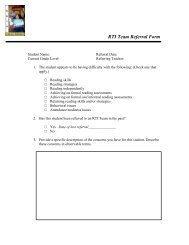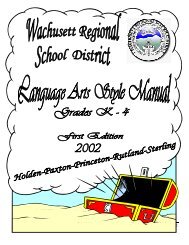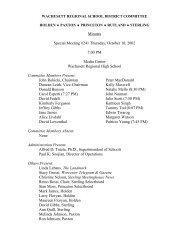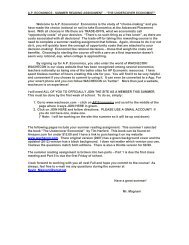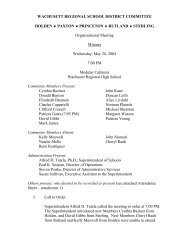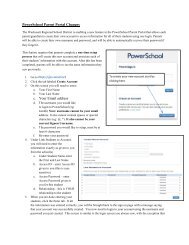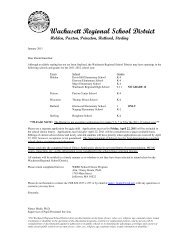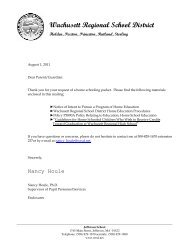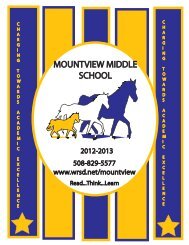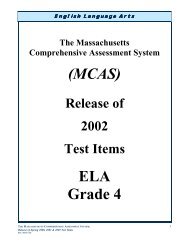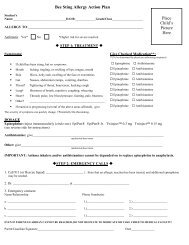Mathematics - Massachusetts Department of Education
Mathematics - Massachusetts Department of Education
Mathematics - Massachusetts Department of Education
Create successful ePaper yourself
Turn your PDF publications into a flip-book with our unique Google optimized e-Paper software.
XV. <strong>Mathematics</strong>, Grade 10
Grade 10 <strong>Mathematics</strong> Test<br />
The spring 2013 grade 10 <strong>Mathematics</strong> test was based on standards in the 2011 <strong>Massachusetts</strong><br />
Curriculum Framework for <strong>Mathematics</strong> that match content in the grade 9–10 standards from the 2000<br />
<strong>Massachusetts</strong> <strong>Mathematics</strong> Curriculum Framework. The standards in the 2011 framework on the<br />
grade 10 test are organized under the five major domains listed below.<br />
Number and Quantity<br />
Algebra<br />
Functions<br />
Geometry<br />
Statistics and Probability<br />
The Curriculum Framework for <strong>Mathematics</strong> is available on the <strong>Department</strong> website at<br />
www.doe.mass.edu/frameworks/current.html. More information and a list <strong>of</strong> standards assessable on<br />
the spring 2013 test are available at www.doe.mass.edu/transition/2013-14g10math.html.<br />
<strong>Mathematics</strong> test results for grade 10 are reported under four MCAS reporting categories, which are<br />
based on the five framework domains listed above.<br />
Test Sessions<br />
The grade 10 <strong>Mathematics</strong> test included two separate test sessions, which were administered on<br />
consecutive days. Each session included multiple-choice and open-response questions. Session 1 also<br />
included short-answer questions.<br />
Reference Materials and Tools<br />
Each student taking the grade 10 <strong>Mathematics</strong> test was provided with a grade 10 <strong>Mathematics</strong><br />
Reference Sheet. A copy <strong>of</strong> the reference sheet follows the final question in this chapter.<br />
During session 2, each student had sole access to a calculator with at least four functions and a square<br />
root key. Calculator use was not allowed during session 1.<br />
The use <strong>of</strong> bilingual word-to-word dictionaries was allowed for current and former English language<br />
learner students only, during both <strong>Mathematics</strong> test sessions. No other reference tools or materials<br />
were allowed.<br />
Cross-Reference Information<br />
The table at the conclusion <strong>of</strong> this chapter indicates each item’s reporting category, the 2011 framework<br />
standard it assesses, and the 2000 framework standard it assesses. The correct answers for released<br />
multiple-choice and short-answer questions are also displayed in the table.<br />
261
Grade 10 <strong>Mathematics</strong><br />
Session 1<br />
You may use your reference sheet during this session.<br />
You may not use a calculator during this session.<br />
DIRECTIONS<br />
This session contains fourteen multiple-choice questions, four short-answer questions, and three<br />
open-response questions. Mark your answers to these questions in the spaces provided in your<br />
Student Answer Booklet.<br />
ID:273329 C Common EQ<br />
● 1<br />
Which <strong>of</strong> the following is equivalent to<br />
the expression below<br />
A. x 3<br />
B. x 4<br />
C. x 8<br />
D. x 12<br />
x<br />
6 2<br />
• x<br />
ID:292914 A Common EQ<br />
● 3<br />
What is the value <strong>of</strong> the expression<br />
below<br />
1<br />
3<br />
A. 38<br />
B. 62<br />
C. 98<br />
D. 114<br />
• 6( 4 9 4 • 9)<br />
ID:294006 CMC122_numberline2.eps A Common EQ<br />
● 2<br />
Which point on the number line below<br />
is closest to the value <strong>of</strong> 152 <br />
J K L M<br />
12 13 14 15 16<br />
A. point J<br />
B. point K<br />
C. point L<br />
D. point M<br />
ID:281587 B Common EQ<br />
● 4<br />
What is the smallest value <strong>of</strong> x that<br />
makes the inequality below true<br />
A. 2<br />
B. 8<br />
C. 16<br />
D. 64<br />
0. 5x<br />
18 14<br />
262
<strong>Mathematics</strong> Session 1<br />
ID:282172 CMC544_drawn_line.eps [st C Common EQ<br />
● 5 Carmen made the scatterplot shown below.<br />
y<br />
x<br />
Which <strong>of</strong> the following shows the data in Carmen’s scatterplot with a line <strong>of</strong> best fit<br />
A. y<br />
C. y<br />
x<br />
x<br />
B. y<br />
D. y<br />
x<br />
x<br />
263
<strong>Mathematics</strong> Session 1<br />
ID:288121 CMC527_apartment.eps D Common EQ<br />
● 6<br />
The line plot below shows the area,<br />
in square feet, <strong>of</strong> each studio in an<br />
art center.<br />
X<br />
X X X<br />
X X X X X X<br />
800 900 1000 1100 1200 1300 1400 1500<br />
Area <strong>of</strong> Studios (in square feet)<br />
ID:279246 B Common EQ<br />
● 8<br />
Which <strong>of</strong> the following expressions<br />
does not equal 0<br />
A. ( 6 2)<br />
2 6<br />
B. ( 2 6)<br />
6 2<br />
C. 6 2 2 6<br />
D. 2 6 6 2<br />
What is the mean area <strong>of</strong> the studios<br />
in the art center<br />
ID:293986 C Common EQ<br />
● 7<br />
A. 700 square feet<br />
B. 1000 square feet<br />
C. 1050 square feet<br />
D. 1080 square feet<br />
Which <strong>of</strong> the following is equivalent to<br />
the expression below<br />
( 0. 4 2) 1.<br />
3<br />
ID:261532 D Common EQ<br />
● 9<br />
The volume <strong>of</strong> a cube is 231 cubic inches.<br />
Which <strong>of</strong> the following is closest to the<br />
length <strong>of</strong> each edge <strong>of</strong> the cube<br />
A. 16 inches<br />
B. 15 inches<br />
C. 7 inches<br />
D. 6 inches<br />
A. 1. 3 ( 0. 4 2)<br />
B. ( 2 0. 4) 1.<br />
3<br />
C. 1. 3 ( 0. 4 2)<br />
D. ( 2 0. 4) 1.<br />
3<br />
264
<strong>Mathematics</strong> Session 1<br />
ID:294637 CMC512_towns.eps C Common EQ<br />
● 10<br />
X<br />
The line plot below shows the area, in<br />
square miles, <strong>of</strong> each town in a county.<br />
X<br />
X<br />
X<br />
X<br />
X<br />
X<br />
X X X<br />
20 25 30 35 40 45 50 55 60 65 70 75 80<br />
Area <strong>of</strong> Each Town in a County<br />
(in square miles)<br />
What is the median area, in square<br />
miles, <strong>of</strong> the towns in the county<br />
A. 50<br />
B. 45<br />
C. 40<br />
D. 35<br />
ID:294682 CMC540_teacher.eps C Common EQ<br />
● 11<br />
The scatterplot below shows the<br />
relationship between the number <strong>of</strong><br />
teachers and the number <strong>of</strong> students at<br />
each school in one school district.<br />
Number <strong>of</strong> Teachers<br />
200<br />
180<br />
160<br />
140<br />
120<br />
100<br />
80<br />
60<br />
40<br />
20<br />
0<br />
Number <strong>of</strong> Teachers and<br />
Students at Each School<br />
200<br />
400<br />
600<br />
Number <strong>of</strong> Students<br />
800<br />
1000<br />
1200<br />
1400<br />
1600<br />
1800<br />
2000<br />
2200<br />
A new school for 1600 students will be<br />
built in the district. Based on the line <strong>of</strong><br />
best fit for the scatterplot, which <strong>of</strong> the<br />
following is closest to the number <strong>of</strong><br />
teachers that will work at the new school<br />
A. 40<br />
B. 70<br />
C. 90<br />
D. 140<br />
265
<strong>Mathematics</strong> Session 1<br />
ID:299936 ESE113_parallelogram.eps C Common EQ<br />
● 12<br />
W<br />
Parallelogram WXYZ and diagonal WY<br />
are shown in the diagram below.<br />
X<br />
Which <strong>of</strong> the following statements best<br />
proves that XWY ZYW <br />
A. If two parallel lines are cut by a<br />
transversal, then corresponding<br />
angles are congruent.<br />
B. If two parallel lines are cut by a<br />
transversal, then complementary<br />
angles are congruent.<br />
C. If two parallel lines are cut by a<br />
transversal, then alternate interior<br />
angles are congruent.<br />
D. If two parallel lines are cut by a<br />
transversal, then alternate exterior<br />
angles are congruent.<br />
Z<br />
Y<br />
ID:294020 B Common EQ<br />
● 13<br />
Mr. Thurman’s lawn is rectangular and<br />
has a width <strong>of</strong> 92 feet and a length <strong>of</strong><br />
147 feet. He is going to cover his entire<br />
lawn with grass seed.<br />
One bag <strong>of</strong> grass seed costs $53.47. The<br />
grass seed in one bag will cover an area<br />
<strong>of</strong> approximately 5000 square feet.<br />
Which <strong>of</strong> the following estimates is<br />
closest to the total cost <strong>of</strong> the bags <strong>of</strong><br />
grass seed Mr. Thurman will need to<br />
cover his lawn<br />
A. $100<br />
B. $150<br />
C. $200<br />
D. $250<br />
ID:278554 B Common EQ<br />
● 14<br />
What is the value <strong>of</strong> x in the solution <strong>of</strong><br />
the system <strong>of</strong> equations below<br />
A. 2<br />
B. 4<br />
C. 10<br />
D. 16<br />
3x<br />
2y<br />
6<br />
x 2y<br />
10<br />
266
<strong>Mathematics</strong> Session 1<br />
Questions 15 and 16 are short-answer questions. Write your answers to these questions in the boxes<br />
provided in your Student Answer Booklet. Do not write your answers in this test booklet. You may do<br />
your figuring in the test booklet.<br />
ID:279302 WDN002_altitude.eps Common EQ<br />
● 15 The diagram below shows a triangle and some <strong>of</strong> its measurements.<br />
10 cm 10 cm<br />
h<br />
12 cm<br />
The triangle has an area <strong>of</strong> 48 square centimeters. What is h, the height, in centimeters, <strong>of</strong> the<br />
triangle<br />
ID:294026 Common EQ<br />
● 16 What is the value <strong>of</strong> the expression below <br />
100 60 4 • 3<br />
267
<strong>Mathematics</strong> Session 1<br />
Question 17 is an open-response question.<br />
• BE SURE TO ANSWER AND LABEL ALL PARTS OF THE QUESTION.<br />
• Show all your work (diagrams, tables, or computations) in your Student Answer Booklet.<br />
• If you do the work in your head, explain in writing how you did the work.<br />
Write your answer to question 17 in the space provided in your Student Answer Booklet.<br />
ID:288090 CMC503_recycle.eps Common EQ<br />
● 17<br />
The scatterplot below shows the number <strong>of</strong> pounds <strong>of</strong> newspaper that a recycling club<br />
recycled per month for 10 months.<br />
Number <strong>of</strong> Pounds<br />
1000<br />
950<br />
900<br />
850<br />
800<br />
750<br />
700<br />
650<br />
600<br />
550<br />
500<br />
450<br />
400<br />
350<br />
300<br />
250<br />
200<br />
150<br />
100<br />
50<br />
0<br />
Number <strong>of</strong> Pounds <strong>of</strong><br />
Newspaper Recycled<br />
1 2 3 4 5 6 7 8 9 10 11 12<br />
Month<br />
a. What is the total number <strong>of</strong> months for which more than 500 pounds <strong>of</strong> newspaper was<br />
recycled per month<br />
b. What is the range <strong>of</strong> the numbers <strong>of</strong> pounds <strong>of</strong> newspaper recycled per month for the<br />
10 months Show or explain how you got your answer.<br />
c. What is the median number <strong>of</strong> pounds <strong>of</strong> newspaper recycled per month for the 10 months<br />
Show or explain how you got your answer.<br />
During months 11 and 12, the club recycled a combined total <strong>of</strong> 600 pounds <strong>of</strong> newspaper.<br />
The range <strong>of</strong> the numbers <strong>of</strong> pounds <strong>of</strong> newspaper recycled per month for the 12 months is<br />
the same as the range for the 10 months.<br />
d. What is the median number <strong>of</strong> pounds <strong>of</strong> newspaper recycled per month for the 12 months<br />
Show or explain how you got your answer.<br />
268
<strong>Mathematics</strong> Session 1<br />
Questions 18 and 19 are short-answer questions. Write your answers to these questions in the boxes<br />
provided in your Student Answer Booklet. Do not write your answers in this test booklet. You may do<br />
your figuring in the test booklet.<br />
ID:294025 Common EQ<br />
● 18 What value <strong>of</strong> n makes the equation below true<br />
2 • n n<br />
ID:254560 Common EQ<br />
● 19 What is the value <strong>of</strong> the expression below<br />
3<br />
4 ( 2)<br />
1<br />
269
<strong>Mathematics</strong> Session 1<br />
Questions 20 and 21 are open-response questions.<br />
• BE SURE TO ANSWER AND LABEL ALL PARTS OF EACH QUESTION.<br />
• Show all your work (diagrams, tables, or computations) in your Student Answer Booklet.<br />
• If you do the work in your head, explain in writing how you did the work.<br />
Write your answer to question 20 in the space provided in your Student Answer Booklet.<br />
ID:294030 Common EQ<br />
● 20<br />
The table below shows the numbers <strong>of</strong> tickets sold for three pr<strong>of</strong>essional baseball games at a<br />
stadium.<br />
Baseball Game Ticket Sales<br />
Day<br />
Number <strong>of</strong> Tickets Sold<br />
Friday 31,937<br />
Saturday 28,359<br />
Sunday 38,031<br />
a. Estimate the difference in the number <strong>of</strong> tickets sold for Friday’s game and the number <strong>of</strong><br />
tickets sold for Sunday’s game. Show or explain how you got your estimate.<br />
For Saturday’s game, the stadium ticket <strong>of</strong>fice sold 71.6% <strong>of</strong> the total number <strong>of</strong> tickets available.<br />
b. Estimate the total number <strong>of</strong> tickets that were available for Saturday’s game. Show or<br />
explain how you got your estimate.<br />
The table below shows the prices <strong>of</strong> tickets that the stadium ticket <strong>of</strong>fice sells.<br />
Prices <strong>of</strong> Tickets<br />
Type <strong>of</strong> Ticket<br />
Price<br />
bleacher $11.25<br />
pavilion $24.75<br />
grandstand $53.75<br />
An equal number <strong>of</strong> bleacher, pavilion, and grandstand tickets are available for each game.<br />
c. Estimate the average price, in dollars, <strong>of</strong> a ticket at the stadium. Show or explain how you<br />
got your estimate.<br />
d. Use your answer from part (c) to estimate the total amount <strong>of</strong> money, in dollars, the<br />
stadium ticket <strong>of</strong>fice received in ticket sales for the games on Friday, Saturday, and Sunday.<br />
Show or explain how you got your estimate.<br />
270
<strong>Mathematics</strong> Session 1<br />
Write your answer to question 21 in the space provided in your Student Answer Booklet.<br />
ID:296368 Common EQ<br />
● 21<br />
A company packages barbeque sauce in two different-sized bottles, small and large. Although<br />
the label on each small bottle states that the bottle contains 18 ounces <strong>of</strong> sauce, the company<br />
allows a tolerance <strong>of</strong> plus or minus 0.25 ounce for the amount <strong>of</strong> sauce in each small bottle.<br />
In manufacturing, tolerance is the amount <strong>of</strong> error that is allowed in packaging a product.<br />
a. What is the maximum amount <strong>of</strong> sauce, in ounces, the company allows in each small<br />
bottle Show or explain how you got your answer.<br />
In the absolute-value inequality below, x represents the amount <strong>of</strong> sauce, in ounces, the<br />
company allows in each small bottle.<br />
x 18 0.<br />
25<br />
b. Solve the absolute-value inequality. Show or explain how you got your answer.<br />
The company also makes a large bottle <strong>of</strong> barbeque sauce.<br />
• The label on the large bottle states that each bottle contains 24 ounces <strong>of</strong> sauce.<br />
• The minimum amount <strong>of</strong> sauce allowed in each large bottle is 23.55 ounces.<br />
• The maximum amount <strong>of</strong> sauce allowed in each large bottle is 24.45 ounces.<br />
c. What is the tolerance, in ounces, the company allows for the large bottle Show or explain<br />
how you got your answer.<br />
d. Write an absolute-value inequality that represents y, the amount <strong>of</strong> sauce, in ounces, the<br />
company allows in the large bottle.<br />
271
Grade 10 <strong>Mathematics</strong><br />
Session 2<br />
You may use your reference sheet during this session.<br />
You may use a calculator during this session.<br />
DIRECTIONS<br />
This session contains eighteen multiple-choice questions and three open-response questions. Mark<br />
your answers to these questions in the spaces provided in your Student Answer Booklet.<br />
ID:294492 CMC411_trapezoid.eps C Common EQ<br />
● 22<br />
The diagram below shows a trapezoid<br />
and its dimensions.<br />
6.7 in.<br />
ID:293168 WDN13_missingscale.eps A Common EQ<br />
● 24<br />
A teacher recorded the height <strong>of</strong> each<br />
student in a class. The bar graph below<br />
shows the number <strong>of</strong> students at each<br />
height.<br />
5.2 in.<br />
7.3 in.<br />
4.3 in.<br />
15.5 in.<br />
What is the area <strong>of</strong> the trapezoid<br />
A. 95.46 in. 2<br />
B. 57.72 in. 2<br />
C. 47.73 in. 2<br />
D. 34.70 in. 2<br />
Number <strong>of</strong> Students<br />
8<br />
7<br />
6<br />
5<br />
4<br />
3<br />
2<br />
1<br />
0<br />
Student Heights<br />
60 61 62 63 64<br />
Height (in inches)<br />
ID:299933 B Common EQ<br />
● 23<br />
Which <strong>of</strong> the following is equivalent to<br />
the expression below<br />
( 6x 4y 9) ( 3x 2y)<br />
A. 3x<br />
2y<br />
9<br />
B. 3x<br />
6y<br />
9<br />
C. 9x<br />
2y<br />
9<br />
D. 9x<br />
6y<br />
9<br />
Which statement about the data in the<br />
bar graph is true<br />
A. The mean is greater than the mode.<br />
B. The median is greater than the mean.<br />
C. The median is the middle number on<br />
the vertical axis.<br />
D. The mode is the largest number on<br />
the horizontal axis.<br />
272
<strong>Mathematics</strong> Session 2<br />
ID:299946 ESE119_inequality.eps [op B Common EQ<br />
● 25 An inequality is shown below.<br />
2 2x<br />
6 12<br />
Which <strong>of</strong> the following graphs represents the solution to the inequality<br />
A.<br />
–6 –5 –4 –3 –2 –1 0 1 2 3 4 5 6<br />
B.<br />
–6 –5 –4 –3 –2 –1 0 1 2 3 4 5 6<br />
C.<br />
–6 –5 –4 –3 –2 –1 0 1 2 3 4 5 6<br />
D.<br />
–6 –5 –4 –3 –2 –1 0 1 2 3 4 5 6<br />
273
<strong>Mathematics</strong> Session 2<br />
ID:294312 CMC326_image.eps D Common EQ<br />
● 26 Triangle T is shown on the<br />
coordinate grid below.<br />
7<br />
6<br />
5<br />
4<br />
R'(2, 3)<br />
3<br />
2<br />
1<br />
(–4, 1)S'<br />
–7 –6 –5 –4 –3 –2 –1 0 1 2 3 4 5 6 7<br />
–1<br />
–2<br />
T'(4, –2)<br />
–3<br />
–4<br />
–5<br />
–6<br />
–7<br />
y<br />
Triangle R S T is the image <strong>of</strong> triangle<br />
RST after triangle RST was translated<br />
3 units to the right and 4 units up.<br />
What were the coordinates <strong>of</strong> point R<br />
before the translation<br />
A. (6, 6 )<br />
B. (5, 7 )<br />
C. (22, 0)<br />
D. (21, 21)<br />
x<br />
ID:294667 D Common EQ<br />
● 27<br />
The table below shows the ranges <strong>of</strong> the<br />
numbers <strong>of</strong> miles that 14 different cars<br />
were driven between oil changes.<br />
Miles Driven between Oil Changes<br />
Range <strong>of</strong> Miles<br />
Driven<br />
Number <strong>of</strong><br />
Cars<br />
1–2,000 2<br />
2,001– 4,000 5<br />
4,001–6,000 4<br />
6,001–8,000 2<br />
8,001–10,000 1<br />
Which <strong>of</strong> the following is the greatest<br />
possible median number <strong>of</strong> miles driven<br />
between oil changes<br />
A. 10,000<br />
B. 7,000<br />
C. 6,000<br />
D. 5,000<br />
274
<strong>Mathematics</strong> Session 2<br />
ID:281729 CMC421_papertube.eps A Common EQ<br />
● 28<br />
The diagram below shows a piece <strong>of</strong><br />
paper that has been rolled to form a<br />
right circular tube.<br />
3 in.<br />
8 in.<br />
ID:294180 B Common EQ<br />
● 29<br />
Brooke rides her bicycle each day.<br />
On Monday, she rode the length <strong>of</strong><br />
Maple Street in 0.4 hour at a constant<br />
speed <strong>of</strong> 15 miles per hour.<br />
What is Brooke’s constant speed if she<br />
rides the length <strong>of</strong> Maple Street on<br />
Tuesday in 0.3 hour<br />
A. 21 miles per hour<br />
B. 20 miles per hour<br />
C. 11 miles per hour<br />
D. 6 miles per hour<br />
Based on the dimensions in the<br />
diagram, which <strong>of</strong> the following is<br />
closest to the lateral surface area <strong>of</strong><br />
the outside <strong>of</strong> the tube<br />
A. 75 sq. in.<br />
B. 82 sq. in.<br />
C. 151 sq. in.<br />
D. 207 sq. in.<br />
275
<strong>Mathematics</strong> Session 2<br />
ID:294645 CMC518_homecoming.eps [op D Common EQ<br />
● 30<br />
Suzanna surveyed some students to find out if they would attend the homecoming game. The<br />
table below shows the students’ responses.<br />
Homecoming Game Survey<br />
Student Response<br />
Number <strong>of</strong> Students<br />
yes 23<br />
no 12<br />
maybe 30<br />
Which <strong>of</strong> the following circle graphs best represents the information in the table<br />
A. Homecoming<br />
Game Survey<br />
C.<br />
Homecoming<br />
Game Survey<br />
Maybe Yes<br />
33 1 33 1 — %<br />
— %<br />
3 3<br />
No<br />
33 1 — %<br />
3<br />
Maybe<br />
50%<br />
Yes<br />
33%<br />
No<br />
17%<br />
B.<br />
Homecoming<br />
Game Survey<br />
D.<br />
Homecoming<br />
Game Survey<br />
Maybe<br />
30%<br />
Yes<br />
23%<br />
Maybe<br />
45%<br />
Yes<br />
35%<br />
No<br />
12%<br />
No<br />
20%<br />
276
<strong>Mathematics</strong> Session 2<br />
Question 31 is an open-response question.<br />
• BE SURE TO ANSWER AND LABEL ALL PARTS OF THE QUESTION.<br />
• Show all your work (diagrams, tables, or computations) in your Student Answer Booklet.<br />
• If you do the work in your head, explain in writing how you did the work.<br />
Write your answer to question 31 in the space provided in your Student Answer Booklet.<br />
ID:296369 Common EQ<br />
● 31<br />
Katya wants to earn $1500 this summer by doing yard work. She plans on working 125 hours<br />
over the summer.<br />
a. Based on her plan, what is the rate, in dollars per hour, that Katya must charge customers<br />
for doing yard work to earn $1500 over the summer Show or explain how you got your<br />
answer.<br />
Katya also wants to enroll in a summer class at a local college. As a result, she will have to<br />
work 50 hours less than the total number <strong>of</strong> hours she had originally planned.<br />
b. What is the rate, in dollars per hour, that Katya must charge customers for doing yard work<br />
to still earn $1500 Show or explain how you got your answer.<br />
c. Write an equation that represents the relationship between x, the number <strong>of</strong> hours Katya<br />
will have to work, and y, the rate she must charge customers to earn $1500.<br />
d. Explain how a change in x, the number <strong>of</strong> hours Katya will have to work, affects y, the<br />
rate she will have to charge customers to earn $1500, in your equation from part (c).<br />
277
<strong>Mathematics</strong> Session 2<br />
Mark your answers to multiple-choice questions 32 through 40 in the spaces provided in your<br />
Student Answer Booklet. Do not write your answers in this test booklet. You may do your figuring<br />
in the test booklet.<br />
ID:294298 CMC312_RST.eps A Common EQ<br />
● 32 The diagram below shows WXY . Point R lies on WY .<br />
X<br />
W<br />
31°<br />
R<br />
83°<br />
18°<br />
Y<br />
Based on the angle measures in the diagram, what is m<br />
WXR<br />
A. 52°<br />
B. 83°<br />
C. 97°<br />
D. 131°<br />
ID:294139 D Common EQ<br />
● 33<br />
The first five terms <strong>of</strong> a geometric<br />
sequence are shown below.<br />
25<br />
2<br />
125<br />
4<br />
625<br />
8<br />
3125<br />
16<br />
15625<br />
32<br />
, , , , , . . .<br />
What is the common ratio <strong>of</strong> the<br />
sequence<br />
A.<br />
B.<br />
C.<br />
D.<br />
5<br />
2<br />
2<br />
5<br />
2<br />
5<br />
5<br />
2<br />
278
<strong>Mathematics</strong> Session 2<br />
ID:288069 CMC426_transamericapyrami C Common EQ<br />
● 34<br />
A right square pyramid and some <strong>of</strong> its<br />
dimensions are shown in the diagram<br />
below.<br />
ID:299949 C Common EQ<br />
● 35<br />
Which <strong>of</strong> the following is equivalent<br />
to the expression below for all positive<br />
values <strong>of</strong> x <br />
Slant height<br />
= 327 ft.<br />
A. 1<br />
x<br />
x<br />
2<br />
2<br />
x 6<br />
5x<br />
6<br />
145 ft.<br />
B.<br />
C. x x<br />
6<br />
11<br />
2<br />
2<br />
What is the lateral surface area <strong>of</strong> the<br />
pyramid<br />
D. ( x 3 )( x 2 )<br />
( x 6)( x 1)<br />
A. 47,415 sq. ft.<br />
B. 68,440 sq. ft.<br />
C. 94,830 sq. ft.<br />
D. 115,855 sq. ft.<br />
279
<strong>Mathematics</strong> Session 2<br />
ID:294293 CMC307_GHJ.eps A Common EQ<br />
● 36<br />
Triangles GHJ and KLM are congruent.<br />
The triangles and some <strong>of</strong> their angle<br />
measures are shown in the diagram<br />
below.<br />
H<br />
ID:294177 A Common EQ<br />
● 37<br />
The distance traveled by a student<br />
walking at a constant rate varies directly<br />
with the amount <strong>of</strong> time the student<br />
walks. The student walked 1 2 3 miles<br />
in 2 3 hour.<br />
M<br />
G<br />
45°<br />
L<br />
105°<br />
K<br />
J<br />
Which <strong>of</strong> the following represents the<br />
relationship between d, the distance in<br />
miles walked by the student, and t, the<br />
amount <strong>of</strong> time in hours the student<br />
walked<br />
5<br />
A. d t<br />
2<br />
7<br />
B. d t<br />
3<br />
10<br />
C. d t<br />
9<br />
Based on the angle measures in the<br />
diagram, what is m JGH<br />
A. 30°<br />
B. 35°<br />
C. 40°<br />
D. 45°<br />
2<br />
D. d t<br />
5<br />
ID:294505 B Common EQ<br />
● 38<br />
The diameter <strong>of</strong> a sphere is 30 centimeters.<br />
Which <strong>of</strong> the following is closest to the<br />
surface area <strong>of</strong> the sphere<br />
A. 377 square centimeters<br />
B. 2,827 square centimeters<br />
C. 11,310 square centimeters<br />
D. 45,239 square centimeters<br />
280
<strong>Mathematics</strong> Session 2<br />
ID:294626 D Common EQ<br />
● 39<br />
The table below shows the distances<br />
jumped by 6 Olympic gold medalists.<br />
Distances Jumped by<br />
Gold Medalists<br />
Gold Medalist<br />
Distance (meters)<br />
Frank Irons 7.48<br />
Albert Gutterson 7.60<br />
William Petersson 7.15<br />
DeHart Hubbard 7.44<br />
Ed Hamm 7.73<br />
Ed Gordon 7.64<br />
What was the median distance jumped<br />
by the gold medalists listed in the table<br />
A. 7.30 meters<br />
B. 7.34 meters<br />
C. 7.51 meters<br />
D. 7.54 meters<br />
ID:253197 inscr_sq.eps B Common EQ<br />
● 40 Square WXYZ is inscribed in circle O,<br />
which has a radius <strong>of</strong> 8 feet, as shown<br />
below.<br />
X<br />
W<br />
O<br />
8 feet<br />
Which <strong>of</strong> the following is closest to the<br />
length <strong>of</strong> WZ <br />
A. 8.0 feet<br />
B. 11.3 feet<br />
C. 13.9 feet<br />
D. 16.0 feet<br />
Y<br />
Z<br />
281
<strong>Mathematics</strong> Session 2<br />
Questions 41 and 42 are open-response questions.<br />
• BE SURE TO ANSWER AND LABEL ALL PARTS OF EACH QUESTION.<br />
• Show all your work (diagrams, tables, or computations) in your Student Answer Booklet.<br />
• If you do the work in your head, explain in writing how you did the work.<br />
Write your answer to question 41 in the space provided in your Student Answer Booklet.<br />
ID:288045 CMC402_fountain.eps Common EQ<br />
● 41<br />
A flower bed in the shape <strong>of</strong> a right triangle has a circular fountain in it. The flower bed and<br />
some <strong>of</strong> its measurements are shown in the diagram below.<br />
16 ft.<br />
20 ft.<br />
Fountain<br />
The perimeter <strong>of</strong> the flower bed is 48 feet.<br />
x<br />
a. What is x, the length in feet <strong>of</strong> the third side <strong>of</strong> the flower bed Show or explain how you<br />
got your answer.<br />
b. What is the area, in square feet, <strong>of</strong> the flower bed, including the fountain Show or explain<br />
how you got your answer.<br />
The circumference <strong>of</strong> the fountain is 8p feet.<br />
c. What is the radius, in feet, <strong>of</strong> the fountain Show or explain how you got your answer.<br />
d. What is the area, in square feet, <strong>of</strong> the flower bed, not including the fountain Show or<br />
explain how you got your answer.<br />
282
<strong>Mathematics</strong> Session 2<br />
Write your answer to question 42 in the space provided in your Student Answer Booklet.<br />
ID:294335 CMC345_KLMN.eps [stem_01, Common EQ<br />
● 42 Quadrilateral KLMN is shown on the coordinate grid below.<br />
y<br />
9<br />
8<br />
7<br />
6<br />
5<br />
4<br />
3<br />
2<br />
1<br />
–9 –8 –7 –6 –5 –4 –3 –2 –1 0 1 2 3 4 5 6 7 8 9<br />
–1<br />
(–6, –2)K<br />
(–7, –5)N<br />
(–3, –6)M<br />
L(–2, –3)<br />
–4<br />
–5<br />
–6<br />
–7<br />
–8<br />
–9<br />
x<br />
Copy the coordinate grid and quadrilateral KLMN exactly as shown onto the grid in your<br />
Student Answer Booklet.<br />
Quadrilateral KLMN will be translated 9 units up.<br />
a. On your grid, draw quadrilateral K L M N , the image <strong>of</strong> quadrilateral KLMN after it has<br />
been translated 9 units up. Be sure to label the vertices.<br />
Quadrilateral K L M N will be reflected over the y-axis.<br />
b. On your grid, draw quadrilateral K L M N , the image <strong>of</strong> quadrilateral K L M N after it has<br />
been reflected over the y-axis. Be sure to label the vertices.<br />
c. Explain whether a 180° rotation <strong>of</strong> quadrilateral KLMN about the origin would result in<br />
vertices with the same coordinates as K L M N .<br />
Quadrilateral K L M N will be rotated 90° clockwise about point M to create<br />
quadrilateral K L M N .<br />
d. What are the coordinates <strong>of</strong> point K <br />
283
<strong>Massachusetts</strong> Comprehensive Assessment System<br />
Grade 10 <strong>Mathematics</strong> Reference Sheet<br />
AREA FORMULAS<br />
square ..................... A = s 2<br />
rectangle ................. A = bh<br />
parallelogram ......... A = bh<br />
triangle ................... A = 1 2 bh<br />
VOLUME FORMULAS<br />
cube .........................................V = s 3<br />
(s = length <strong>of</strong> an edge)<br />
right rectangular prism ............V = lwh<br />
OR<br />
V = Bh<br />
(B = area <strong>of</strong> a base)<br />
trapezoid ................. A = 1 2 h(b 1 + b 2 )<br />
circle ....................... A = pr 2<br />
LATERAL SURFACE AREA FORMULAS<br />
right rectangular prism .......... LA = 2(hw) + 2(lh)<br />
right circular cylinder ........... LA = 2prh<br />
right circular cone ................. LA = pr<br />
( = slant height)<br />
right square pyramid ............. LA = 2s<br />
( = slant height)<br />
sphere ......................................V = 4 3 pr3<br />
right circular cylinder .............V = pr 2 h<br />
right circular cone ...................V = 1 3 pr2 h<br />
right square pyramid ...............V = 1 3 s2 h<br />
CIRCLE FORMULAS<br />
C = 2pr<br />
A = pr 2<br />
TOTAL SURFACE AREA FORMULAS<br />
SPECIAL RIGHT TRIANGLES<br />
cube ....................................... SA = 6s 2<br />
right rectangular prism ......... SA = 2(lw) + 2(hw) + 2(lh)<br />
x<br />
45˚<br />
x<br />
2<br />
sphere .................................... SA = 4pr 2<br />
right circular cylinder ........... SA = 2pr 2 + 2prh<br />
45˚<br />
x<br />
right circular cone ................. SA = pr 2 +pr<br />
( = slant height)<br />
right square pyramid ............. SA = s 2 + 2s<br />
( = slant height)<br />
y<br />
60˚<br />
2y<br />
30˚<br />
y 3<br />
284
Grade 10 <strong>Mathematics</strong><br />
Spring 2013 Released Items:<br />
Reporting Categories, Standards, and Correct Answers*<br />
Correct Answer 2000<br />
Item No. Page No. Reporting Category** Standard**<br />
(MC/SA)*<br />
Standard***<br />
1 262 Algebra and Functions 8.EE.1 C 10.P.4<br />
2 262 Number and Quantity 8.NS.2 A 10.N.3<br />
3 262 Number and Quantity 7.EE.3 A 10.N.2<br />
4 262 Algebra and Functions A-REI.3 B 10.P.6<br />
5 263 Statistics and Probability S-ID.6 C 10.D.2<br />
6 264 Statistics and Probability 6.SP.5 D 10.D.1<br />
7 264 Number and Quantity 7.EE.3 C 10.N.1<br />
8 264 Number and Quantity 7.NS.3 B 10.N.2<br />
9 264 Number and Quantity 8.NS.2 D 10.N.3<br />
10 265 Statistics and Probability 6.SP.5 C 10.D.1<br />
11 265 Statistics and Probability S-ID.6 C 10.D.2<br />
12 266 Geometry 8.G.5 C 10.G.3<br />
13 266 Number and Quantity 7.EE.3 B 10.N.4<br />
14 266 Algebra and Functions A-REI.6 B 10.P.8<br />
15 267 Geometry 7.G.6 8 cm 10.M.1<br />
16 267 Number and Quantity 7.EE.3 55 10.N.2<br />
17 268 Statistics and Probability S-ID.2 10.D.1<br />
18 269 Algebra and Functions A-REI.3 n = 0 10.P.6<br />
19 269 Number and Quantity 7.NS.3 36 10.N.2<br />
20 270 Number and Quantity 7.EE.3 10.N.4<br />
21 271 Algebra and Functions A-REI.3 10.P.6<br />
22 272 Geometry 7.G.6 C 10.M.1<br />
23 272 Algebra and Functions A-APR.1 B 10.P.3<br />
24 272 Statistics and Probability 6.SP.5 A 10.D.1<br />
25 273 Algebra and Functions A-REI.3 B 10.P.6<br />
26 274 Geometry G-CO.5 D 10.G.9<br />
27 274 Statistics and Probability S-ID.2 D 10.D.1<br />
28 275 Geometry 7.G.6 A 10.M.2<br />
29 275 Algebra and Functions A-CED.1 B 10.P.7<br />
30 276 Statistics and Probability 6.SP.4 D 10.D.1<br />
31 277 Algebra and Functions A-CED.2 10.P.7<br />
32 278 Geometry 8.G.5 A 10.G.5<br />
33 278 Algebra and Functions F-BF.2 D 10.P.1<br />
34 279 Geometry 7.G.6 C 10.M.2<br />
35 279 Algebra and Functions A-SSE.2 C 10.P.4<br />
36 280 Geometry G-SRT.5 A 10.G.4<br />
37 280 Algebra and Functions A-CED.2 A 10.P.7<br />
38 280 Geometry 7.G.7 B 10.M.2<br />
39 281 Statistics and Probability 6.SP.5 D 10.D.1<br />
40 281 Geometry G-SRT.6 B 10.G.6<br />
41 282 Geometry 7.G.4 10.M.1<br />
42 283 Geometry G-CO.5 10.G.9<br />
* Answers are provided here for multiple-choice and short-answer items only. Sample responses and scoring guidelines for open-response items, which are<br />
indicated by the shaded cells, will be posted to the <strong>Department</strong>’s website later this year.<br />
** The Reporting Category and Standard columns refer to the current (2011) curriculum framework for <strong>Mathematics</strong>. More information about reporting<br />
categories for <strong>Mathematics</strong> is available on the <strong>Department</strong>’s website at http://www.doe.mass.edu/mcas/tdd/math.htmlsection=testdesign.<br />
*** The <strong>Department</strong> is providing the standard from the previous (2000) curriculum framework for <strong>Mathematics</strong> for reference purposes.<br />
285




